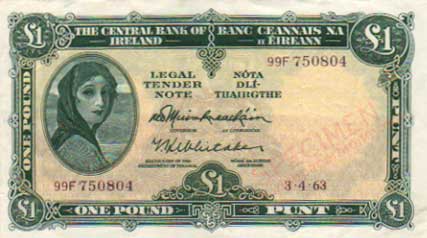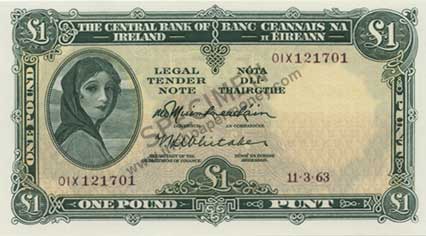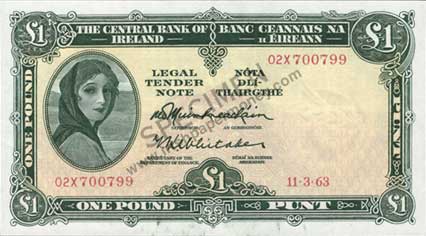In May 1974 £1 notes dated 11.3.63 (Type 11: M. Ó Muimhneacháin, T. K. Whitaker signatures) were issued into circulation by the Central Bank of Ireland during a shortage of £1 notes. When issued, the notes caused a good deal of public disquiet and were suspected of being forgeries by people, as they had no metallic security thread in them. The metallic thread had been introduced in 1971 on notes of Type 13 (T. K. Whitaker, C. H. Murray signatures).
To restore public confidence the Central Bank of Ireland had to take the unusual step of stating that the notes were genuine (Irish Numismatics No.40), and old stock issued in response to a shortage of One Pound notes. This Extraordinary Issue of notes was quickly forgotten about by the public at large, but proved to be of continuing interest to the collector community. The reason for their existence remains a bit of a mystery.
Illustrated below are a normal G prefix £1 note, with 01X and 02X prefix notes. The 01X prefix note here also has 'black' mulberry serial numbers.

£1 note 3.4.63, issued in 1963 with a standard issue prefix. Prefixes F and G were used in this era.


£1 note 11.3.63, issued in 1974 as an Extraordinary Issue.
By the time that the 11.3.63 dated £1 notes were issued in 1974, banknote collecting was well established as a hobby in Ireland and the UK. These notes were spotted immediately by collectors and caused a great stir in numismatic circles, because of their prefix and their recent date, both previously unknown.
During the 1970s examples of all but a very few £1 note dates had been recorded—fewer than 10 dates remained to be seen by then, and there were at least four date collections being worked on by active note collectors in Ireland. One of those collectors was a wages clerk in a large company in the 1960s and 1970s, and had access to vast quantities of 10 shilling and One Pound notes. All post-1950 dates were common. Thus, it is highly unlikely that any £1 notes dated 11.3.63 would have been missed had they already been in circulation before 1974, even considering their very small relative printage.
Bearing an unusual prefix (01X and 02X) outside of the normal prefix run of F, or G, those in use on £1 notes in the early 1960s, these banknotes were a very odd issue. This focussed attention on them. Thus, they were saved in UNC in quantity, and are the only Type 11 notes which are not rare in UNC grade. So, whilst 11.3.63 has by far the lowest printage of Type 11, it is not a rare date.
The fact that notes dated 11.3.63 also turned up as mulberry variety notes adds to their interest. An on-going survey of the notes indicates that all two million notes might have gone into circulation, although the Central Bank of Ireland stated initially that £120,000 face value were issued (Irish Numismatics, No. 40). It is also possible that others may also have been printed beyond 02X, and never issued.
Speculation is that the notes were a special printing of some kind, most likely column sort notes or star replacement notes which were not then used. We know that they were printed, dated and numbered with the other Type 11 notes (Muimhneacháin, Whitaker signature combination) as the mulberry variation occurs on them with a similar frequency to the other mulberry £1 notes of this era.
If they were column sort notes, then it would be expected that at least one million notes would exist, as the run of 3.4.63 is around 27 million. It is known that there were 24 notes printed per sheet for these £1 notes. Based on 24 notes per sheet, two million notes is likely to be too many for the 11.3.63 notes to be column sorts.
The second theory, that they were printed for use as star replacement notes, and never used as such, is more likely, in view of the quantity involved, although two million replacement notes is a lot to print and number in advance for a print run of sixty eight million standard issue notes (considering standard issue 1962 and 1963-dated £1 notes together). Normal replacement note occurrence has been shown to be approximately 0.54% (Irish A Series £1 notes, LRNC) and 0.62% in certain US notes (Feller, S., IBNS Journal, 1995).
Special Sections and Articles
The Transition of Irish Currency, Irish banknotes 1918–1928
The Partition of Irish Currency, Irish banknotes 1928–1930
Banknote Design Evolution 1824 to 1916
Irish Three Pound Notes
Contemporary Forgeries of Early Irish Banknotes, ca1800-1930
Limerick Soviet Notes
Irish World War 2 Banknote Issues
Low Number Irish Banknotes
Irish Joint Stock Banks of Note Issue from 1783
Irish Legal Tender Note Specimens
Ploughman Scan Survey (PSS)
1 Pound Ploughman
5 Pounds Ploughman
10 Pounds Ploughman
20 Pounds Ploughman
50 Pounds Ploughman
100 Pounds Ploughman
Irish Ten Shilling Notes
1 Pound Note Lady Lavery
5 Pounds Lady Lavery
10 Pounds Lady Lavery
20 Pounds Lady Lavery
50 Pounds Lady Lavery
100 Pounds Lady Lavery
1 Pound Note, Queen Medb
5 Pound Note, John Scotus Eriugena
10 Pound Note, Jonathan Swift
20 Pound Note, W. B. Yeats
50 Pound Note, Turlough O'Carolan
100 Pound Note, Grace O'Malley
5 Pound Note, Sister Catherine McAuley
10 Pound Note, James Joyce
20 Pound Note, Daniel O'Connell
50 Pound Note, Douglas Hyde
100 Pound Note, Charles Stewart Parnell
Northen Ireland Polymer notes
Bank of Ireland Polymer Notes
Danske Bank Polymer Notes
Ulster Bank Polymer Notes